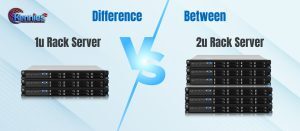
A specialized enclosure made to hold IT equipment is called a server rack. It offers servers UPS systems switches and other IT equipment a safe and well-organized environment. Server racks are available in a range of shapes and sizes from compact desktop units to massive floor-standing models. The various kinds of racks and how to choose the best one for your requirements will be discussed in this article.
Where in the server rack is U?
High-precision hardware used to manage business operations is housed in server cabinets and racks. But how to figure out what size these furniture pieces should be is the question. A special value was picked for this purpose. A rack unit or U rack dimension is the height of a piece of server furniture. This measurement indicates how tall the device that is supported by the server furniture is.
The size of the U in racks is 175 inches or 44 by 45 mm. (). This measurement is made to accommodate all of the hardware. Larger hardware larger than 1U is assigned values like 2U 6U and 12U. They offer space to store several gadgets or a large piece of equipment.
In what way did the server rack U standard originate?
The idea of rack units which became a standard in the server rack industry is where the U meaning originates. To facilitate compatibility between server furniture and equipment the Electronic Industries Association (EIA) led the charge for this standardization.
- You may come across a rail with irregular hole spacing without such standards rendering it incompatible.
- The user experience is made simpler by the adoption of these standards which guarantee that their current equipment will work seamlessly with any new purchases they make.
- Without these guidelines producers may be more likely to create proprietary systems that would force consumers to use only their particular product ecosystems.
- For measurement information you can also consult the manufacturers dimensional documents even though the EIA-310 document is available for purchase on the IHS market.
- Determining the precise origins of the term rack unit is difficult due to the widely used EIA-310-D version which was created in 1992. But its extensive use shows how important it is as a standard in the field.
Segregating 1U and 2U Rack Servers
Each rack server has different technical components of it and here, we are enlisting them to make it an easy comparison:
| Attributes | 1U | 2U |
| Height | 1.75 inches (44.45 mm) | 3.5 inches or 88.9 mm |
| Weight | 19 inches (482.6 mm)-standard rack width | 19 inches or 482.6 mm |
| Depth | 20-40 inches (508-1016 mm) | 20-40 inches or 508-1016 mm |
| Components |
|
|
| Cooling |
|
|
| Use Cases |
|
|
Basic Difference Between 1U and 2U Rack Server
Therefore the following distinctions between 1U and 2U rack servers should be taken into account. The density in relation to:
- Expandability: When space is at a premium 1U servers can accommodate more servers in a rack. Meanwhile 2U servers are more expandable and typically perform better when more storage or processing power is required; they also occupy less vertical space.
- Noise and Cooling: Because of their smaller fans, faster speed and more compact design, 1U servers are noisier and hotter. For settings where noise is an issue 2U servers are a better option because they are cooler and possibly quieter.
- Scalability and performance: 2U servers typically allow for additional high-performance components and future upgrades making them more appropriate for applications that require scaling up even though both 1U and 2U servers can be extremely powerful.
- Efficiency of Power: Because 1U servers typically carry fewer components and are smaller they typically use less power per server. However 2U servers provide greater overall efficiency for applications that demand the highest performance. Because they can frequently combine workloads that would otherwise be split among several 1U servers.
- Price: Because 1U servers have fewer components and a smaller footprint they are initially less expensive. In long terms, though, 2U servers can pay for themselves when frequent upgrades or high performance are required to maintain applications.
What Impact Does a Server Case Have on Performance?
The servers practical performance is influenced by the unique characteristics of each server case. Server hardware operation depends on air conditioning mountings for extra cooling devices like fans or water coolers and airflow chambers help to maintain the operating temperature within reasonable bounds. Thermal throttling brought on by inadequate cooling shortens the internal components lifespan and performance.
Furthermore the components that will fit into the server case are determined by its format which is 1U 2U and 3U. While a more compact case will be made for mobile environments it will have fewer expandability options than a larger case. Excellent ultra-thin server cases also offer improved cable management and vibration isolation which boosts efficiency and helps prevent problems.
What distinguishes 1U, 2U, 3U, and 4U server cases from one another?
Rack units or RUs which are sometimes just referred to as U are used to measure rack-mounted equipment. RUs are the primary unit of measurement for servers and their cases that are meant to be installed inside an equipment rack.
- A 2U is 3point 5 inches tall, a 3U is 5point 25 inches tall and a 4U is 7 inches tall. For example one rack is equivalent to 1.75 inches or 44.45 mm. Comparing server cases in terms of height and size.
- At 1.75 inches in height the 1U server case is the smallest and uses the least amount of rack space. Places where making the most of available space is a top priority can use these cases.
- 2U Server Case: With more internal space these cases stand about 3 to 5 inches tall. They allow for additional cooling and space for two storage devices or other parts like two CPUs. 3U Server Case:
- 3U cases have a height of 5. 25 inches. More room is available with these thin server cases which also work with servers that have cooling cells or other sophisticated customizations installed.
- The largest server case in the comparison measures 7 inches in height. It supports specialized hardware efficient cooling systems and high-performance components.
Summary
Applications that require more power storage or just more space overall like database servers or virtualization hosts. This decision would be influenced by a number of factors including budgetary restrictions, power and cooling capacities, the utilization of available rack space to the fullest extent possible and current and future performance requirements.










